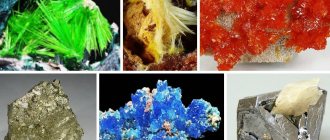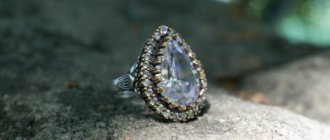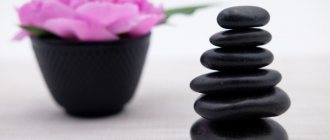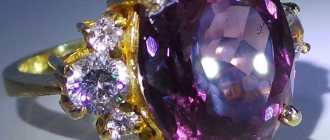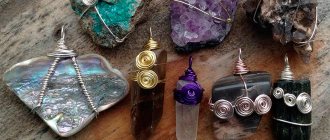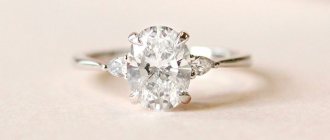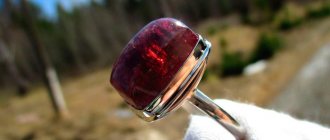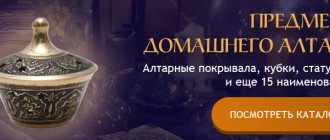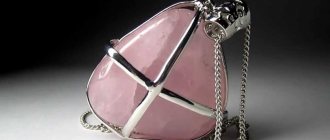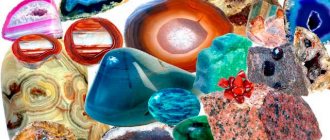Since ancient times, people have used precious minerals to make jewelry. At first, using methods of description and observation, our ancestors tried to classify gems. In the treatise “On Stones,” which Theophrastus wrote in 315 BC, one can find both a systematization of minerals and theories of their origin. Later in the Middle Ages, lapidariums appeared - collections of valuable stones. Lapidariums belong to the genre of descriptive poetry, symbolic literature. Such works not only describe precious or semi-precious stones, but attribute to them symbolic significance and certain magical properties. The first lapidary was written by the king of Arabia, Evax. He called his work “The Lapidarium of King Evax” and presented it as a gift to Emperor Tiberius.
THIS IS INTERESTING . Today, about 2.5 thousand minerals are known, however, only about a hundred of them are considered valuable. Minerals are compounds formed naturally during complex geological transformations. Thus, minerals consist of inorganic substances and have a crystalline structure. In jewelry, in addition to mineral gems, organic materials can also be used.
The scientific branch that studies precious minerals is called gemology (from the Latin word “gemma” means “precious stone”).
Gemology studies the properties of valuable minerals (optical, chemical, physical), their structure, patterns of location of deposits, technical characteristics of stone processing. In 1908, the National Association of Jewelers (NAJ), which is now better known as the Gemological Association of Great Britain, was founded. In any state where jewelry is traded, there are laboratories of gemologists. They can be both public and private. But all gemological laboratories serve one goal - to minimize the risks of buying fakes and low-quality products.
According to their origin, all precious minerals are divided into natural and artificial. Natural ones are formed during natural processes. Synthetic minerals are obtained in laboratory conditions; they are similar to natural ones in their structure and properties. Artificial minerals are inferior in price to natural ones and, as a result, are used as a material for creating various instruments.
Types of Gemstones
The classification of jewelry used by jewelers and gem dealers is extremely difficult to understand and confusing. Today, jewelers do not have a generally accepted division of precious stones. The most common classifications are according to Sobolevsky, Gurich, Kluge, and Kievlenko. Let us dwell on the 1973 classification, which was developed by E.Ya. Kievlenko. She systematized minerals, taking into account the market value of precious stones, their applicability in the production of jewelry and other craft items. Kovalenko E.Ya. divides gems into the following groups: ornamental, jewelry and precious stones, which in turn are divided into orders. The value of a mineral directly depends on the rank of its order - the higher the order, the more expensive the value of the mineral.
Gems
A mineral that is characterized by a high degree of hardness and transparency is considered precious. Such minerals can look like new for a long time and do not lose color (if any). At the head of this group are diamonds. Along with them, blue sapphires, emeralds and rubies are included
in the first order of the first group Diamonds have the highest price among other precious stones. They are obtained during diamond processing. Diamonds are the hardest natural mineral structures.
According to Mohs, they have a strength of 10 maximum points. Diamonds are several dozen times stronger than sapphires, which are rated 9 on the Mohs scale. There is an opinion that the word “diamond” comes from the Greek word “adamas” - “indestructible”; another version says that from the Persian “elma” - “hardest”. Emeralds are green beryls that are exceptionally transparent.
Their color is due to the presence of chromium or vanadium in the composition. Beryls are not very hard, but they are incredibly expensive. Dark green beryls of Colombia are considered high-grade, in the crystals of which vanadium is found. Rubies are distinguished by their rich red color. According to their chemical composition, they, like sapphires, belong to the corundum species. From Latin the word “rubeus” is translated as “red”. The most valuable are red rubies with a slight bias towards a violet hue. This color is also called “pigeon blood” color. It is quite rare to find rubies that contain rutile inclusions. Such stones will have a star-shaped optical effect (asterism effect).
Sapphires are characterized by high transparency. The presence of titanium and iron gives the mineral a blue tint. Depending on the predominance of one or another element, the shades of sapphires range from dark blue, ultramarine, cornflower blue to pale blue.
The second order of the first group includes sapphires of fancy colors, alexandrites, jadeites and black opals.
Alexandrite is chrysoberyl, which has the ability to change color depending on the nature of the lighting. So, in daylight the mineral will have a green color, and in artificial light it acquires a red-violet hue. A similar ability is given to alexandrite by particles of trivalent chromium. Opals by their chemical nature are silica hydrogels, that is, amorphous quartz that contains up to 10% water.
The most valuable is the noble black opal, which is characterized by iridescent tints on its surface. Typically, opals are not cut and are shaped into cabochons. The third order of the first group includes white and fire opals, peridot, spinel, aquamarines, topazes, moonstone and red tourmaline.
Topaz is a fluorine-containing aluminum silicate.
Topazes are a prime example of stones that got their name from the area where they were mined. Few people know that the modern island of St. Johns, located in the Red Sea, was previously called Topazos. These stones usually have pink, yellow or golden hues. There are topazes with pronounced opalescence - topaz “cat's eyes”. Topaz is a mineral with a bright shine that tolerates any treatment, including grinding. According to the Mohs scale, the density of topaz is estimated at eight points out of ten maximum. IV order of gemstones includes blue, green, pink and polychrome tourmaline, hyacinth, beryl, turquoise, amethyst, chrysoprase, garnet, citrine and noble spodumene.
Turquoise is called the “stone of heaven” - this mineral is a hydrated phosphate of copper and aluminum.
Copper ions give turquoise its sky blue color. Iron impurities can give greenish tints to the mineral. Turquoise is a gemologist's nightmare. It is almost impossible to verify its authenticity. Most often, turquoise is imitated with glass and porcelain. Jewelry and ornamental stones are characterized by low hardness, they are opaque, but have a beautiful natural color and often have a characteristic pattern.
The first order of the second group includes rauchtopaz, rock crystal, jadeite, jade, lapis lazuli, malachite and aventurine.
Malachite .
From the Greek “malakos” is translated as “soft”. The name itself indicates that malachite by nature does not require much effort in processing. Malachite can have turquoise, emerald, bluish or black-green colors. In nature, malachite is located in kidney-shaped masses, due to which a concentric pattern is visible on the saw cuts. In the old days, malachite was called “peacock stone.” The second order of jewelry and semi-precious stones includes agate, colored chalcedony, heliotrope, rose quartz, labradorite and other opaque iridescent spars.
Ornamental stones
Ornamental minerals include such minerals as jasper, granite, marble onyx, obsidian, marble and others. They are used as inserts and decoration of stone-cutting products (ashtrays, caskets, etc.).
Pomegranate
Magic properties
: A stone of love that can arouse love passions and cheer the soul. A stone of anger and passion, drives away sadness and brings joy to the owner. Stimulates will and endurance, promotes the development of self-esteem. Gives power over people. A symbol of fidelity, faith, devotion and strength.
Medicinal properties
: Provides pregnant women with a safe delivery. Positively affects digestion, breathing, blood circulation and the immune system. Pomegranate necklaces help with high fever, sore throat and long-term headaches.
Classification by groups
One of the difficulties in dividing precious stones into groups is their names, many of which were assigned in ancient times. It happened that the name of a mineral came from the place of its extraction or from its color characteristics. For example, golden-colored stones were called topaz, blue minerals were called sapphires. In addition, one mineral could have several fixed names. To resolve this situation, modern mineralogy introduced the concepts of species, groups and varieties of minerals.
Now the type of mineral consists of crystals of the same chemical composition. For example, aluminum oxides are corundum, beryllium and aluminum silicate are beryl. Based on the degree of transparency of the mineral and its color characteristics, one type can be divided into varieties. Species similar in chemical composition form groups of minerals.
Group of pomegranates
The garnet group is a broad type of mineral that belongs to the silicate class.
Typical representatives of the group are grant, rhodolite, grossularide, andralite, pyrope. Garnet is a dark red mineral. This gemstone has many names. In particular, Pliny the Elder called a mineral similar to flickering coals a carbuncle (from “carbon” - “coal”). Garnets, along with other red gems, were sometimes called anfrax. In Ancient Rus', pomegranates were known as chervetsy, becheta, and venice.
Rhodolite is translated from Greek as “pink stone”. Rhodolites are a type of pyrope, which is a silicate from the garnet group. Large rhodoliths are relatively expensive.
Quartz group
Quartz is silica dioxide.
This is the most common mineral. Regular glass or translucent grains of sand on the beach are great examples of quartz. Quartz is a large group of minerals. In particular, rock crystal is nothing more than its transparent variety. Amethyst is a variety of quartz that is characterized by a violet color ranging from dark purple to pinkish.
Amethysts are mined in Brazil, Uruguay and Sri Lanka. Amethysts are relatively inexpensive; this fact is primarily explained by the presence of artificial amethysts on the market, which are extremely difficult to distinguish from natural ones. Jasper is a whole class of minerals that consist of siliceous rocks with various impurities: chalcedony, iron, aluminum; constituting up to 20% of the crystal. The Greek word “iaspis” is translated as “variegated,” which indicates the color diversity of this mineral.
Group of organic materials
Organic materials are formed by a living being and, to varying degrees, consist of organic and inorganic parts. This group of materials includes coral, pearls, amber and jet.
Pearls do not require additional processing. This material is formed in the body of mollusks inside the oyster bag. A mollusk, when a particle of a foreign substance enters its body, envelops it in layers of calcium carbonate, held together by organic matter. The more layers, the larger the pearl. The growth of pearl layers is a very slow process. Natural pearls are found not only in white colors. It can be yellow, blue, red and even black.
Feldspar group
Feldspars are silicon silicates that make up up to 50% of the mass of the earth's crust.
When feldspars break down, sedimentary rocks and clay are formed. Feldspars can often be found combined with quartz crystals. Feldspars include albite, labradorite, anorthite and other minerals. Labradorite is an opaque dark blue feldspar. If you polish this mineral well, you can achieve an interesting optical effect when golden, blue, indigo and green “lights” shimmer across the surface of the mineral. In Finland, labradors are mined, which are cast in all the colors of the rainbow. They are called spectrolites.
Group of Jades
Jades are a group of translucent minerals of pyroxene and amphibole composition.
Jades include: vesuvianite, grossularite, calcite, obsidian and chrysoprase. Jadeite is the same as jade. Jadeite is a type of jade, which is distinguished by impurities of sodium compounds.
The mineral is quite durable and well valued. Hard jadeite is highly polished, so the stone can be given shine. Chromium and iron give jadeite its green color. Particularly prized is the translucent “noble” or “imperial jade,” which is mined in Burma. Obsidians are volcanic glass. In nature, you can find obsidians in black, gray, yellow, red and brown colors. Gray-white obsidians are called snow obsidians. Pendants, pendants and rosaries are often made from this stone.
Agate
Magic properties
: in Ancient Rome, agate was the stone of the fertility goddess Pomona, so nowadays jewelry made of agate can be given as gifts to farmers and gardeners you know. Gives the owner courage and longevity. Symbol of health and prosperity. Can protect against energetic attacks and “energy vampirism”, taking on negative energy. Arriving home, such a stone must be “cleaned” by holding it in cold water, and thanked for your care and salvation. A ring with agate gives men charm in the eyes of women. Agate jewelry can calm a baby, it helps him get to his feet earlier and protects him from the evil eye. Helps athletes achieve athletic success and calm anger.
Medicinal properties
: increases potency, helps with long-term coughs and throat diseases, relieves cramps, helps fight fears, protects against infections and stomach diseases. Blue agate has an effect on the thyroid gland, yellow agate treats the respiratory and digestive organs, red agate has an effect on the vascular system and viral diseases.
Types of cuts
Its brilliance and the play of light on the surface largely depend on the cut of a gemstone. Cutting refers to the technique of processing a mineral, upon completion of which a certain shape of a stone is formed with a certain number of faces, their location, proportions relative to each other and characteristic outlines. Let's look at the most commonly used types of cuts:
Round cut
Number of faces: 17, 33, 57
The round cut is something of a classic. The history of this cut goes back more than a hundred years. It is perfect for diamonds, as it collects and enhances the shine of the stone. In addition, the round cut protects the gemstone from chips and other damage. The lighter the stone (the smaller the carat), the fewer facets the jeweler will carve. Fly in the ointment - with this cut, up to 50% of the original weight of the gem is lost.
Oval cut
Number of faces: 57
This option for cutting stones has been known since the 60s of the 20th century. The “oval” cut has a more elongated shape than the round cut; and allows the stone to play with iridescence in the light. Gems cut into oval shapes are often used in rings to visually lengthen the fingers.
Marquise cut
Number of faces: 55
The Marquise cut is similar to a boat and is an oblong oval with pointed corners at the edges. As with the oval cut, the marquise cut on the ring elongates the fingers. However, be aware that the sharp wedges at the ends of the stone will become vulnerable and brittle.
Drop cut (Pear)
Number of faces: 55-56
The “Drop” combines the features of the “Marquise” and “Oval” cuts - on one side the gem will have a rounded end; and on the other hand, it’s spicy. The sharp end acts as a vulnerable point of the gemstone, prone to cracks. Therefore, experienced jewelers try to protect it with a frame. A teardrop-shaped cut of a gem in a necklace or necklace will advantageously lengthen the neck.
Princess cut
Number of edges: 49, 65,68
The “Princess” has a square or more often rectangular shape. Like the round cut, the Princess cut maximizes the brilliance and brilliance of the gem. In addition, when choosing this cut, the nugget will lose less of its original weight. This cut is often used for engagement ring diamonds. Like any other sharp corners, the tops of the “Princess” must be reliably protected by the frame.
Cabochon
Cabochoning is a method of processing stone to give it a rounded, convex shape (sometimes flat on one side). Most often, this cutting method is used when processing impenetrable or low-permeability stones; as well as stones that have any optical effects (for example, asterism or opalescence).
How gold, silver and other metals affect the body
Gold
Gold - if stolen or obtained dishonestly, brings great misfortune. If acquired through blood (taken from a killed person or taken out of a grave), it acts like a time bomb - for many years it attracts terrible troubles, which tend to be inherited in subsequent generations.
Silver
Silver symbolizes the emotional world of man. It is associated with prayer, which is why icon frames are often made of silver. This metal, when oxidized, darkens in different people at different rates. Occultists believe that this phenomenon occurs due to the ability of silver to record mental states and experiences, which occurs individually for each person.
Copper
Most works of art in ancient times were made from copper or its alloys. Copper is able to identify and clarify feelings, making them permanent and durable. It smooths out conflicts and evens out even the most unstable relationships. The purest copper is that which is obtained electrochemically under vacuum conditions (electrolysis).
Copper helps with magnetic storms and during periods of active solar radiation; relieves excitement, screens excess energy. People who have character traits such as inertia and long periods of time in business should not wear copper products (they may become completely lazy).
Tin
Tin is a metal associated with patriotism and strengthening social authority. In churches and Christian communities, many holy relics are kept in tin boxes. In Hellenic culture, figurines of home guardians were made from tin.
Zoroastrians in India and Iran still melt tin in a flat vessel with high walls (on strictly certain days). Peering at the patterns, they receive messages from the spirits of their ancestors.
Classification by quality
This list of qualities is responsible for the visual beauty and aesthetics of the stone.
Color
It is impossible to determine the type of mineral solely by color. Even minerals of the same type vary significantly in their shades depending on the presence of certain impurities. The average buyer can easily confuse, for example, topaz and sapphire. And only an experienced homologist, using special crystallographic methods, will be able to determine whether a mineral belongs to a certain species. By color there are white, yellow, purple, red, green, black, pink and blue gems.
Transparency
Transparency is a very important property of a gemstone, on which its price largely depends.
Gemologists understand transparency as the ability of a mineral to transmit light through itself. The transmission of light is influenced by the structure of the crystal; as well as the presence in the structure of the mineral of defects or inclusions that distort the flow of light. The degree of light transmission of a certain mineral is determined by a spectrophotometer. According to the degree of transparency, minerals are divided into:
- absolutely transparent - lightly colored or colorless gems, through which objects are clearly seen, without any changes;
- half transparent - colored and colorless stones, through which you can observe objects distorted or blurred;
- minerals that transmit light in thin layers. Light can usually only penetrate the surface layer, but nothing can be seen through the crystal as a whole;
- opaque - do not allow light to pass through.
Shine
Luster refers to the ability of a mineral to refract or reflect light. There are the following types of shine in precious stones:
- Diamond - the reflection of light from the surface is quite strong. Diamonds and zircon, for example, have a diamond-like luster.
- Glassy – reflects light like glass. As an example, we can name, for example, corundum.
- Waxy - slight gloss on a matte surface. Turquoise and jasper have a waxy luster.
- Metallic – strong shine on the surface of opaque minerals. For example, hematite, pyrite.
- Resinous - amber.
- Mother-of-pearl or multi-colored shimmer - pearls, opal.
Hardness
The degree of hardness of gems is determined by the Mohs scale from one to ten maximum points.
As standards, each point corresponds to a specific mineral. The undisputed leaders of the Mohs scale are diamonds - 10, followed by corundum - 9. The hardness of topaz is estimated at 8 points. Topazes are followed in descending order by quartz - 7 points, orthoclase (opal) - 6, apatite - 5, fluorite - 4, calcite - 3, gypsum - 2 and talc - 1. The arrangement of other minerals is determined by their ability to scratch each other's surface. If the material under study scratches the standard, then its hardness is higher than the hardness of the given standard; if not, lower. The harder the mineral, the denser it is, the longer it retains its cut, does not wear off and looks new.
Turquoise
Magic properties
: Symbol of good luck and victory; accompanies success in financial affairs and attracts money; promotes peace in the family, stopping quarrels between spouses. A stone of brave people who are not afraid of risks and strive for victory. Jewelry with turquoise creates fearlessness, fortitude and assertiveness.
Medicinal properties
: Strengthens vision, relieves insomnia and nightmares, relieves headaches; has a positive effect on the vocal cords and thyroid gland. A fading or greening stone is a signal of the onset of a disease (the color of the stone can also deteriorate from exposure to soap, alcohol, perfume, and fats)
Malachite
Magic properties
: Talisman of Bohemia; stone of wisdom, helps to make the right decisions. Symbol of wish fulfillment. Talisman of doctors and scientists. One of the strongest and oldest amulets for children, especially at the head of a child. There are many legends associated with malachite: those who drink from a malachite cup understand the language of animals; can make a person invisible. Absorbs energy, so it needs to be cleaned after each use, otherwise the stone will become dull and lose its strength.
Medicinal properties
: Treats diseases of the blood, eyes, cardiovascular system, skin; helps with mental disorders, toothache, poisoning; used for seizures, joint diseases, asthma, pancreatitis, diabetes, creates harmony between the sexes. Works great in beads and rosaries.
Quartz
Magic properties
: Rose quartz is a talisman of love, love and hope; helps achieve what is desired by carrying out the necessary harmonization. Smoky quartz is a powerful amulet; can only be used by strong individuals.
Medicinal properties
: Used to treat cardiovascular diseases, venous vessels. Improves the functions of the kidneys and gonads, relieves stress, calms. Helps with insomnia, anemia, sore throat, stimulates sexual energy. Treats drug addicts and people addicted to various negative habits.
Coil
Magic properties
: According to ancient legend, Adam, choking on the apple of knowledge, spat out a piece of the coil. Therefore, the serpentine is called “Adam’s stone” and is considered a symbol of temptation and possible sin. Sometimes it is worn by people who seek to deliberately deceive others. It is recommended to be worn by people who want to avoid dangers on the path of life. It is a vampire stone capable of absorbing any type of negative energy.
Medicinal properties
: Helps with headaches, can awaken from lethargy and accelerates bone healing.
Amber
Magic properties
: A guardian stone that wards off the evil eye and evil spell. A source of creative strength, faith and optimism, it clarifies thoughts and helps to implement plans. Brings good luck and maintains health. An amulet over a child's cradle against fright.
Medicinal properties
: Helps stop bleeding, strengthens teeth, regulates sexuality, resolves tumors, protects pregnancy, helps with thyroid diseases, insomnia, cramps, headaches, coughs.
